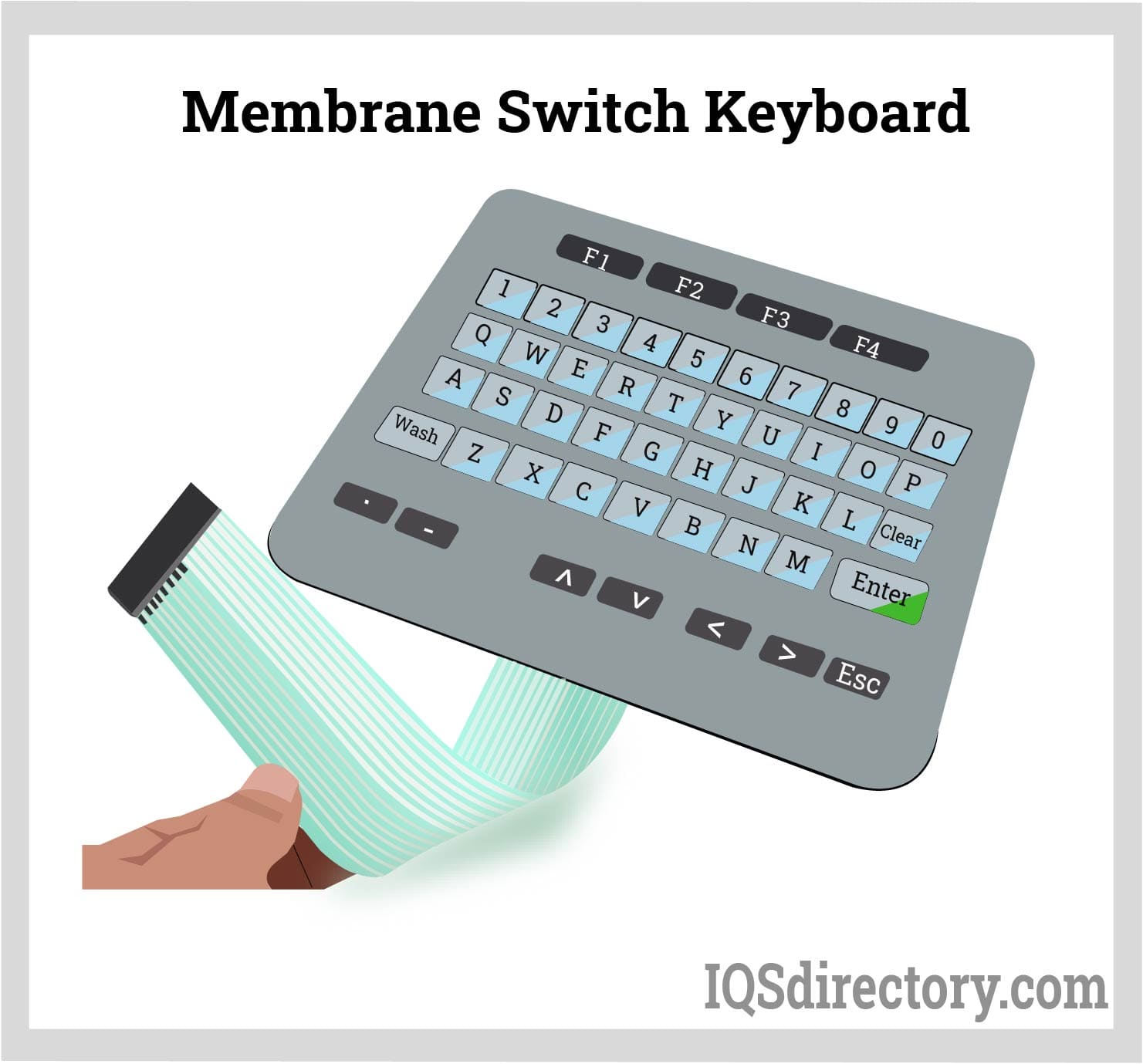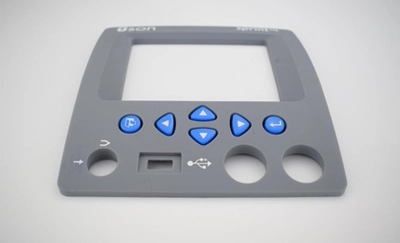Everything About Membrane Change: A Comprehensive Guide for Beginners
Membrane layer switches are important components in contemporary electronics, providing a distinct interface for individual interaction - membrane switch. Their split building, consisting of overlays and conductive traces, offers performance and toughness. Unlike conventional mechanical switches, membrane switches present a streamlined style and personalized options. Understanding their essential features and benefits can change item design. The ins and outs of their application and design factors to consider require additional exploration.
What Is a Membrane layer Switch over?
A membrane layer button is a kind of electrical switch that contains a versatile membrane layered over a printed motherboard. This design enables for a smooth and small user interface, commonly used in different electronic gadgets. Membrane buttons are commonly found in consumer home appliances, medical tools, and commercial machinery because of their durability and resistance to ecological factors.The construction generally consists of numerous layers, such as graphic overlays and glue support, which give responsive responses and safeguard the wiring below. The operation of a membrane button is launched when stress is related to the surface, completing an electrical circuit.These switches are valued for their adaptability, making it possible for custom-made layouts and printed graphics that deal with certain interface. Their inconspicuous nature minimizes room needs, making them ideal for applications where conventional buttons might not fit. In general, membrane switches provide a useful and aesthetic option for contemporary digital gadgets.
Secret Elements of Membrane Layer Switches Over
Membrane layer switches comprise several crucial parts that add to their performance and efficiency. The leading layer, understood as the overlay, offers the interface and is usually published with signs or graphics. Beneath the overlay exists a spacer layer, which separates the conductive elements and avoids inadvertent activation. The next essential element is the graphic layer, which improves aesthetic appeals and assures the toughness of the design.Conductive traces, typically made from materials like silver or carbon, are published on the circuit layer. When pressure is put on the overlay, these traces enter into call, finishing the circuit. In addition, a support layer uses architectural assistance and can be made from products such as polyester or polycarbonate. With each other, these elements create a trustworthy, user-friendly interface appropriate for different applications, from family home appliances to industrial devices. Understanding these elements is crucial for anyone curious about membrane button technology.
How Membrane Layer Switches Over Job
Recognizing exactly how membrane switches function is vital for appreciating their widespread usage in different devices. A membrane button runs with a collection of layers, including a visuals overlay, spacer, and a circuit layer. When pressure is applied to the overlay, it presses the spacer layer, allowing the circuit layer to make get in touch with and complete an electric circuit. This activity sends out a signal to the tool, motivating a feedback, such as switching on a light or activating a function.Membrane switches over can be created with numerous attributes, including tactile responses, backlighting, and customized graphics, enhancing customer interaction. Their building permits a closed layout, securing the interior components from dirt, dampness, and contaminants. This toughness makes them appropriate for varied applications, from consumer electronics to industrial devices. Overall, the simplicity and performance of membrane changes add to their appeal in modern technology.
Advantages of Membrane Layer Switches Over Over Mechanical Switches
While mechanical buttons have long been a staple in numerous devices, membrane layer changes offer distinct benefits that make them increasingly appealing. One significant benefit is their slim account, permitting more small styles and better versatility in product advancement. Additionally, membrane layer switches attribute a consistent surface, which improves aesthetic charm and streamlines cleaning, making them ideal for atmospheres where hygiene is critical.Another advantage is their resistance to dirt and moisture. Unlike mechanical switches, which can be endangered by ecological aspects, membrane layer buttons give a sealed interface that safeguards against contaminants - membrane switch. Membrane layer switches typically have a longer life expectancy due to less relocating components, resulting in enhanced toughness and reliability.Cost-effectiveness is likewise a notable advantage, as membrane buttons can be generated in mass with reduced manufacturing prices. These aspects integrate to position membrane buttons as a sensible alternative to traditional mechanical options in different applications
Typical Applications of Membrane Layer Switches
Membrane layer switches are commonly used in numerous fields, particularly in customer electronics and industrial control panels. In customer tools, they give a smooth, straightforward interface, while in commercial setups, they enhance sturdiness and capability. Comprehending these applications highlights the convenience and functionality of membrane switches in modern innovation.
Consumer Electronics Instruments
As consumer electronic devices proceed to develop, membrane layer switches have come to be a popular selection for a selection of tools as a result of their convenience and streamlined design. These switches are commonly located in mobile phones, tablet computers, and push-button controls, where area is restricted and aesthetics matter. Their low account and adjustable styles enable suppliers to produce easy to use user interfaces that improve the overall customer experience. In addition, membrane buttons are usually made use of in home appliances such as microwaves and coffee machine, providing instinctive control options while withstanding moisture and dust. The toughness and reliability of membrane switches over make them appropriate for daily consumer products, guaranteeing long life and regular More Info efficiency. Generally, their combination in customer electronics reflects a blend of performance and modern-day layout.
Industrial Control Panels
The applications of membrane changes prolong beyond customer electronic devices, locating considerable usage in commercial control panels. These switches are preferred for their longevity and resistance to extreme settings, making them suitable for making and process control settings. They supply a reliable interface for operators to control machinery, screen processes, and readjust settings. Membrane layer buttons can be personalized to fit certain functional needs, integrating attributes like backlighting and tactile comments, enhancing customer experience. Their inconspicuous style permits assimilation right into various tools, while their capacity to withstand spills, dirt, and severe temperature levels warranties long life. Generally, membrane layer buttons add to risk-free and efficient procedure in commercial applications, demonstrating their convenience and efficiency sought after atmospheres.
Factors To Consider for Designing Membrane Switches Over
When making membrane switches, choosing the right products is crucial to assure sturdiness and functionality. In addition, recognizing layer setup techniques can significantly influence the switch's efficiency and user experience. These factors to consider play an important function in developing effective and trusted membrane switch layouts.
Material Choice Value
Product choice plays an important function in the design and performance of membrane switches. The picked products directly influence the button's resilience, responsive action, and total aesthetic. Trick considerations consist of the substratum, which should supply structural integrity while allowing for versatility, and the graphic overlay, which requires to be resistant to use and ecological factors. Conductive materials need to guarantee trustworthy electric efficiency, while adhesives need to provide strong bonding without compromising the switch's operation. Additionally, compatibility with manufacturing processes and end-user atmospheres is essential; materials need to endure varying temperature levels, moisture levels, and chemical direct exposure. Eventually, appropriate product selection not just improves the membrane layer button's efficiency however likewise contributes to its durability and individual satisfaction, making it an important aspect of the layout procedure.

Layer Configuration Techniques

Often Asked Questions
For How Long Do Membrane Layer Switches Over Usually Last?
Membrane switches normally have a lifespan of 1 to 5 million cycles, depending upon usage and environmental conditions. Factors such as style quality and operating regularity substantially influence their longevity and overall efficiency long life.

Can Membrane Layer Switches Be Personalized for Certain Styles?
Membrane buttons can certainly be tailored to accommodate certain layouts, enabling diverse forms, colors, and functionalities. This convenience enables manufacturers to tailor these buttons to satisfy unique visual and functional needs successfully.
What Materials Are Made Use Of in Membrane Switch Construction?
Membrane layer buttons are commonly built making use of products such as polyester, polycarbonate, and sticky layers. These products supply resistance, flexibility, and sturdiness to ecological factors, guaranteeing the switches operate effectively in different applications and problems.
Are Membrane Layer Switches Over Resistant or waterproof to Wetness?
Membrane layer buttons can be developed to be moisture-resistant, using specialized finishes and materials. Their water resistant capacities depend on construction high quality and certain applications, making it crucial to analyze needs for optimal efficiency in various settings.
Exactly How Are Membrane Layer Switches Over Fixed if Damaged?
Fixing broken membrane layer switches over generally entails changing the affected layer or circuit. Service technicians may also apply conductive sticky or utilize specialized repair service packages, guaranteeing performance is brought back without total replacement of the entire button assembly. Unlike traditional mechanical buttons, membrane layer switches present a streamlined layout and personalized choices. A membrane layer button is a type of electrical switch that consists of an adaptable membrane layer layered over a printed circuit board. The procedure of a membrane layer button is started when stress is used to the surface, finishing an electric circuit.These buttons are valued for their versatility, allowing customized designs and published graphics that cater to particular customer interfaces. While mechanical switches have actually long been a staple in numerous tools, visit here membrane switches over deal distinctive advantages that make them significantly appealing. Membrane layer buttons commonly have a longer life-span due to less moving components, check these guys out resulting in enhanced toughness and reliability.Cost-effectiveness is additionally a noteworthy benefit, as membrane buttons can be generated in mass with lower production costs.